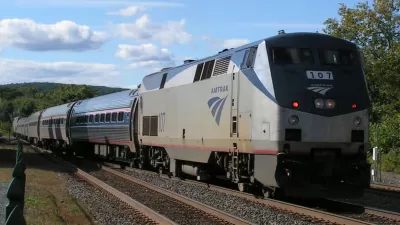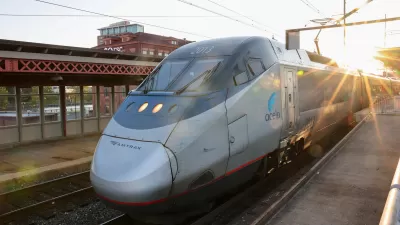In a segment for WNYC, journalist Simon van Zuylen-Wood discusses Amtrak's current status as a "national embarrassment." Decades of lackluster investment, he argues, make it difficult to prove demand in the first place.

Since its establishment in 1971, Amtrak has been a "money-losing ward of the federal government." Politicians eager to cut excess spending frequently target its low ridership, patchy service, and regular delays. Though these criticisms contain some truth, van Zuylen-wood has faith that Amtrak will "muddle through," as it has so many times in the past.
Compared to its analogues in East Asia and Europe, American passenger rail is simply an ineffective way to get around the country. A possible exception is Amtrak's Northeast corridor Acela line, which still pales in comparison to, say, Japan's shinkansen. Throughout the half-hour segment, van Zuylen-Wood covers how this inferiority came to be. Reasons include:
- During the 20th century, rail transport—freight excepted—took on a "collectivist veneer," which also hurt urban light rail.
- The possibly mistaken belief that flying is faster.
- In the United States, passenger trains share track with freight trains, which often monopolize the system.
- It is impossible to prove demand for passenger rail with no adequate initial investment.
- Other national governments see passenger rail as necessary infrastructure (how we view roads and highways) and do not demand profitability.
FULL STORY: The "Embarrassment" of Amtrak

Maui's Vacation Rental Debate Turns Ugly
Verbal attacks, misinformation campaigns and fistfights plague a high-stakes debate to convert thousands of vacation rentals into long-term housing.

Planetizen Federal Action Tracker
A weekly monitor of how Trump’s orders and actions are impacting planners and planning in America.

In Urban Planning, AI Prompting Could be the New Design Thinking
Creativity has long been key to great urban design. What if we see AI as our new creative partner?

King County Supportive Housing Program Offers Hope for Unhoused Residents
The county is taking a ‘Housing First’ approach that prioritizes getting people into housing, then offering wraparound supportive services.

Researchers Use AI to Get Clearer Picture of US Housing
Analysts are using artificial intelligence to supercharge their research by allowing them to comb through data faster. Though these AI tools can be error prone, they save time and housing researchers are optimistic about the future.

Making Shared Micromobility More Inclusive
Cities and shared mobility system operators can do more to include people with disabilities in planning and operations, per a new report.
Urban Design for Planners 1: Software Tools
This six-course series explores essential urban design concepts using open source software and equips planners with the tools they need to participate fully in the urban design process.
Planning for Universal Design
Learn the tools for implementing Universal Design in planning regulations.
planning NEXT
Appalachian Highlands Housing Partners
Mpact (founded as Rail~Volution)
City of Camden Redevelopment Agency
City of Astoria
City of Portland
City of Laramie





























